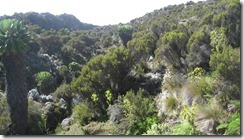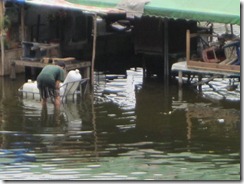December 27, 2010.
I woke up around 5:00 a.m. and had a light breakfast with fruit and boiled eggs. A fellow climber, Kay, marveled at how small the bananas were, “adorable and sweet” as she put it. We dined by candlelight when the power cut out. After breakfast we packed up and trundled down to the hotel’s front entrance with our luggage in tow. I had brought a bit more gear than the other climbers. Based on recommendations from my wife who had climbed Kilimanjaro the year before, I brought items that she thought were necessary to reach the summit. I brought a small day pack to wear and packed my other gear in a large duffle bag and a smaller bag to be carried by porters. Even though we were responsible for getting our bodies to the top, the support team toted most of our belongings.
The drive to the Rongai Route from Arusha was a three-hour long bumpy affair. Our transport was a 1990s minivan with obviously worn shock absorbers that subjected our bums to every speed bump and pothole en route. We took in all the sights, sounds and smells that passed us by, including the sooty fumes of smoking vehicles that would never have passed a DMV inspection in the United States. The middling air conditioning did not hold the heat of the day at bay and left us uncomfortably warm. We stopped several times along the way to pick up supplies, which slowed us down considerably. Our guide, August, told us that he had been unable to buy supplies the day before because all the stores had closed for Christmas; I suspect that picking up supplies such as propane for the cook stove on the way was standard procedure for him. In hindsight, it might have been better for us to have stayed in Moshi closer to the Kilimanjaro National Park entrance at Marangu, or to choose another route closer to Arusha such as the Shira or Machame. The Rongai Route is the furthest climbing route from Arusha. Contrary to guides who might push you to stay in Arusha’s higher priced hotels because they cut a deal with management, Moshi is a perfectly acceptable place to stay the night before the climb. There are at least two decent hotels in Moshi much closer to most of the Kilimanjaro climbing routes.
The Rongai Route (formerly known as Nalemalu) is on the north side of the mountain approaching the summit from the Kenyan border. A lesser used route, its main advantages over other climbing options are that is moderately difficult, sheltered from the elements, and less crowded. Some say it’s more scenic too, although a more accurate assessment is that the scenery is more Alpine than other routes. Marangu, aka the Coca-Cola Route, is the most popular route. It’s longer and more gradual a climb to Kibo Hut, the base camp below the summit. The Shira Route is the longest and most likely to offer animal sightings; August told us that guides are required to carry firearms in the event the group stumbles upon a predator. The Macambe Route, aka the Whisky Route, is the shortest, steepest, and (some say) offers the best chance of success at summiting the mountain. I chose the Rongai Route, which we affectionately dubbed the “Kilimanjaro Beer” Route, based on the recommendation of my wife and other climbers who climbed it the year before. Climbing in her footsteps was an important consideration for me. I wanted to relive her experience as closely as possible. We could not climb Kilimanjaro together because we did not want to leave our young son alone over the holidays and opted to climb separately. Following her example gave me the chance to know firsthand what she went through to reach the top.
To be continued…




Have enjoyed hearing about your journey. I look forward to hearing the rest!
Hi Becky, thanks for writing and highlighting my blog. Glad you like the stories about Kilimanjaro. I’ll post updates over the next week or so and add some photos too. Enjoy!